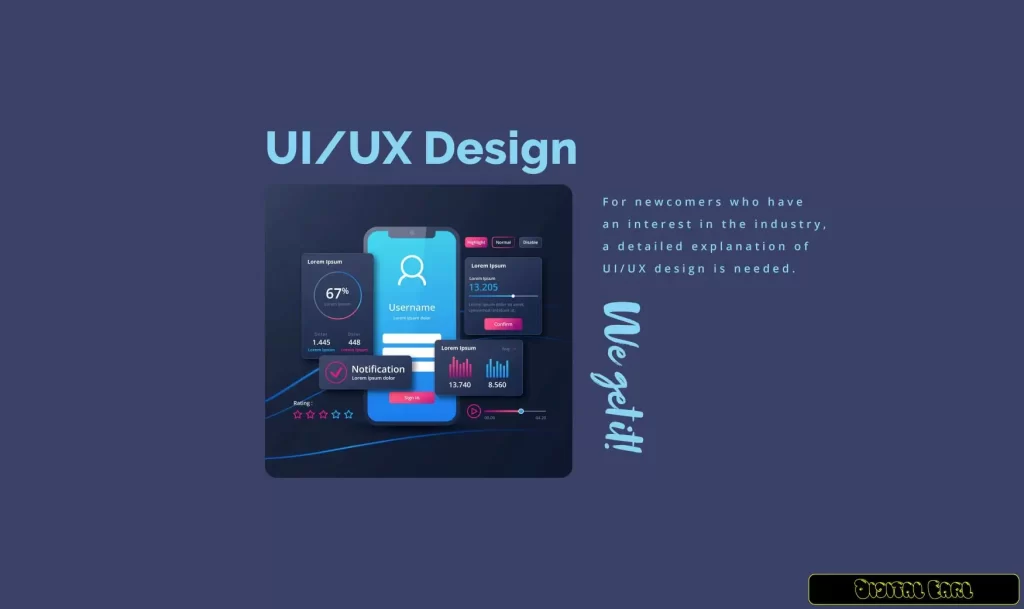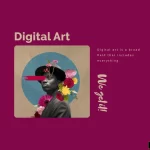The essence of UI/UX design, In today’s constantly innovating digital environment, User Interface (UI) and User Experience (UX) design are becoming the vital forces in determining how we engage with technology. For newcomers who have an interest in the industry, a detailed explanation of UI/UX design is needed. This comprehensive guide provides the necessary knowledge on the basics, career options, and practical possibilities of UI/UX design the way you will have a solid base to start off your journey.
1. Decoding UI and UX: Understanding the Basics
To start your UI/UX journey, you need to first understand the basic definitions and differences between these two related but distinctive fields:
User Interface (UI) Design:
Where UI design entails visual edifices and active extensions, which incite might the users on digital platforms. It’s the craft of building interfaces not just with a beautiful look but also with an intuitive and pleasant to use design. UI designers duty is to do:
- Creating aesthetically appealing layouts
- Designing a navigation system that is easily understood
- Selecting good color schemes and typography for the digital medium
- Producing responsive and interactive elements such as buttons and forms
User Experience (UX) Design:
Being a unique journey, UX design covers everything a user interacts with when using a product or service. It’s not just about the visual interface but also about ensuring that the entire interaction is flawless, fun, and worth it to the users. UX designers concentrate on:
- Surveying and creating user personas for the products and services to be made
- Charting out the user paths and flows
- Building prototypes and testing them
- Checking the users’ satisfaction and development and conducting iterative improvements
Despite being different from each other, both UI and UX harmoniously complete one another to produce products that are both pleasing to the eye and user-centric.
1. The UI/UX Designer’s Toolkit Essential Skills and Tools
When UI/UX designers are beginning their venture into these domains, it is important for them to have knowledge of various tools and methodologies for constructing their concepts:
Wireframing
Wireframing is the fundamental necessity of any design project. It is the process of making simple, schematic layouts in order to properly organize the interfaces. Tools like Balsamiq and Wireframe.cc are the most preferred tools for this purpose.
Mockups
Mockups, on the other hand, are detailed and photorealistic visual representations of the prototype. They aid in the visualization of designs in a more realistic manner. Adobe Photoshop and Sketch are the common choices when creating high-fidelity mockups.
Prototyping Tools
Designs need prototyping for the purposes of testing and mending. Among the several prototyping tools available are:
- Sketch: The best vector design and prototype creator
- Figma: A user interface design tool that supports collaboration
- Adobe XD: A UX/UI solution for web and mobile design
- InVision: A good choice for making interactive prototypes
User Research Tools:
Understanding the users’ requirements is paramount in the UX design. Tools like UserTesting, Hotjar, and Google Analytics help in data collection and interpretation.
2. A Day in the Life of a UX Designer
In the interest of developing a practical vision of the day-to-day routine in the career, here’s a brief look into a usually typical day for a UX designer:
- Morning: Start my day with checking the feedback and analytics data. Also, we often hold a team meeting where we talk about our progress and difficulties.
- Mid-morning: I conduct interviews or analyze the outcomes of surveys to engage in the user research activities. Then I may create the updated ones based on new insights.
- Afternoon: Work jointly with UI designers and developers to tweak the designs and be absolutely sure of its practicality. This may include making new sketches, modifying wireframes, or improving the prototypes.
- Late Afternoon: I run tests on the prototypes that are already in the current testing phase and then inspect the results. It may include being a mediator at the testing session or reviewing the recorded sessions respectively.
- End of Day: Aggregate results and draw up the reports for stakeholders. Plan a to-do list for tomorrow and update the task management tools.
In addition to the aforementioned activities, UX designers often take part in client meetings, contribute to brainstorming sessions and facilitate workshops in order to come up with new ideas and solve design problems.
3. UI/UX Design and Coding Dispelling Myths
One that is often heard from the newcomers’ is whether UI/UX design is prone to coding skills or not. We will address this issue:
Does UI/UX design require coding? The short answer is no; it’s not a must-know skill. However, knowing HTML, CSS, and JavaScript at a basic level can be very helpful for individuals. Let’s say here’s why:
- Better Collaboration: Learning some coding knowledge can help you explain your ideas with developers better.
- Realistic Designs: The ability to code will make it possible for you to design things that can actually be coded into websites or apps.
- Prototyping: Basic coding proficiency can be of good help in delivering more interactive prototypes.
- Career Advancement: When considering such special positions as UX Engineers, then being able to code is obligatory.
Although coding is not a necessity, it could be an advantage that would make you stand out.
4. Career Prospects in UI/UX Design
If you’re thinking about becoming a UI/UX designer, then you’re on the right track. Here’s why you should definitely choose this field:
High Demand:
Companies have moved to a user-centric point of view across all industries which is why UI/UX designers are needed more and more. They have come to understand that the product design is the biggest factor for the success of their products and services.
Diverse Industries:
UI/UX skills are indispensable in various fields, which include the following:
- Technology and Software
- E-commerce and Retail
- Healthcare
- Finance and Banking
- Education
- Entertainment and Media
Creative and Analytical Balance:
The profession of UI/UX design perfectly fuses artistic work with research based activities, which is therefore great for those who like both types of work. You will be using your creative abilities while untangling complex user experience problems.
Impactful Work:
As a UI/UX designer, you have the authority to design products and services that could intensely involve the people thus their digital life would be more intuitive and interesting.
Career Growth:
There are numerous directions anyone can take related to this job, i.e. from being a specialist to becoming a leader who holds the UX Manager or Design Director position within the company.
5. Starting Your UI/UX Journey: Practical Steps
Are you eager to enter the world of UI/UX design? Here are the simple ways to get you started:
1. Build Your Skills:
- Online Courses: Educational institutions like Coursera, Udacity, and Interaction Design Foundation offer versatile UI/UX courses.
- Bootcamps: Choose among the various UI/UX design bootcamps, which are quite hands-on and will teach you the basics of the craft.
- Books and Blogs: Try reading widely about the principles of designing products, user psychology, and industry trends.
2. Create a Portfolio:
Portfolios are the best showcases of your skills and they are essential for you to make an impression on potential employees and clients. In this regard, do the following first:
- Upload personal projects
- Redesigns of the current websites or apps
- Fictional case studies
3. Gain Practical Experience:
- Internships
- Freelance projects
- Volunteer work for non-profits
4. Network and Stay Inspired:
- Get involved in the design communities such as Dribbble and Behance
- Check out the design meetups and conferences that are supported locally
- Be a trustworthy follower of industry leaders and companies through social media
5. Develop Soft Skills:
Not only technical, but interpersonal skills make up the complete picture of a UI/UX designer. Emphasize the skills connected to common sense, such as:
- Good communication
- Empathy
- The capability of seeing a perspective and developing a plan
- Collaboration and personal work ethics
Embracing the UI/UX Design Journey
UI/UX design is not just about the development of elegant interfaces; it is essentially the improvement of the entire user experience and finding solutions to real-life problems through the art of design. As you’re going to be diving into this interesting field, remind yourself that every pro was once a newbie. With diligent work, a curious mind, and enough tenacity, you can master the skills required for a good UI/UX designer, and at the same time, you can make a significant impact in the digital sphere.
Be it the case where you are pursuing a new career or planning to upgrade your current skill set, the field of UI/UX design offers vast possibilities for growth and creativity. Always remember, it’s your own initiative that you can take if you be able to change the digital future. The world of UI/UX design is in need of your vision and creativity!



